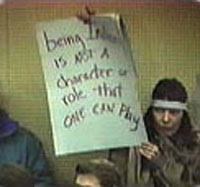1998 But it is still a stereotype. I think everybody can agree, it is a stereotypical image of a native person – the same kind of buckskin – and headdress-wearing, turn-of-the-century chief symbol from the plains tradition that Hollywood uses.
Illiniwek under siege
Efforts to dump the Chief gather momentum,
while defenders stand fast
1998 May 15, Herald and Review
Urbana – An American Indian student arrived on the University of Illinois campus 10 years ago and almost immediately challenged the school’s mascot, Chief Illiniwek, as a racist stereotype.
A decade later, Chief Illiniwek is still standing. The university tightly limits its use, it’s called an “official symbol” instead of a mascot and its defenders say it honors American Indian culture.
But there are signs that momentum is swinging in favor of those who oppose Chief Illiniwek – a 72-year-old tradition featuring a student who performs in Indian regalia at halftime of football and basketball games.
The student who raised the first objection, Charlene Teters, still actively opposes the Chief, though she lives in New Mexico.
 |
| Charlene Teters |
Her story was one of the focuses of the documentary “In Whose Honor” on Chief Illiniwek. It aired nationally on PBS last summer and generated editorials in newspapers across the country on the use of American Indian mascots, nicknames and symbols at sports events. [Click here to watch the documentary, In Whose Honor, on Youtube]
The university history and anthropology departments recently took public stands against the Chief. And last week the university’s faculty-senate voted 97-29 in favor of an advisory resolution calling for the Chief’s retirement.
One place support for Chief Illiniwek seems as strong as ever is with the nine-member board of trustees. And since the trustees, who are appointed and serve six-year terms, have final say in the matter, the debate over the chief could continue to divide the campus into the next century…..
“The reality is, over the course of 10 years, the anti-chief movement has not gone away,” [Pat Hofmann said, a member of the group Students for Chief Illiniwek). “By ignoring it we allowed them the opportunity to increase their organization, increase their numbers and become a very visible presence on this campus.”
 |
| 1953 April 25, Alton Evening Telegraph |
“We need to get organized and counter their misinformation” Hofmann said….
 |
| 1984 Aug 23, Quad City Times |
Chief Illiniwek began in 1926 when an assistant band director decided to have a student perform an American Indian dance in a homemade costume during half-time of a football game. The Chief currently wears an outfit purchased in 1983 from a Sioux chief, along with a headdress of turkey feathers and face paint.
When Teters arrived on campus in 1988, she says she was confronted with “Illini Squaw” contests, bars that advertised themselves as home of the “Drinking Illini” and cartoonish images of Chief Illiniwek image on merchandise.
The university has cracked down on such obviously offensive depictions. In the early 1990s, the chief was declared an official symbol of the university and administrators and trustees never refer to it as a mascot. Chief Illiniwek’s only appearances are at halftime of football and basketball games, he doesn’t speak, and he doesn’t interact with players, fans or cheerleaders.
“You don’t see stuffed dolls of the chief like you see of Bucky Badger at Wisconsin,” Hodmann said. “I know of nothing on campus more dignified and honorable than the symbol of chief Illiniwek.
But American Indian student Bill Winneshiek said he feels the limits placed on the chief show the university knows the symbol is offensive.
“If this is their honored symbol, why is it not on the university letterhead? Why is it not on their business cards? When their mascot gets out and does his little routine it’s a mockery.”
Todd Wallace, who served as a campus’ student representative to the board of trustees last year, does not understand why there is no talk of compromise between the two sides.
“I wish people were suggesting how chief Illiniwek could be changed to make it more accurate. Unfortunately, no one is talking about that,” he said. “The anti-chief people want nothing and the pro-chief people aren’t talking at all.”
~~~~~~~~~~~~~~~~~~
Charlene Teters, a University of Illinois graduate and Spokane Indian who raised the first objections to chief Illiniwek in 1988, said she understands how students and alumni can get so attached to a representation of their university.
“But there is an invisible Indian community there that has a very difficult time being heard because of the university’s use of that mascot and identity,” she said, adding that she feels chief Illiniwek is a “litmus test” for American Indian students who must pick sides when they attend the University of Illinois.
And that choice, she said, determined how they are treated on campus.
Teters admits the university has “sanitized” the chief’s image, tightly controlling its use.
“But it is still a stereotype. I think everybody can agree, it is a stereotypical image of a native person – the same kind of buckskin – and headdress-wearing, turn-of-the-century chief symbol from the plains tradition that Hollywood uses.
“A university and educational institution should not be using a stereotype of any race as its symbol,” she said.

 |
| 1998 May 15, Herald and Review |



Comments
Post a Comment